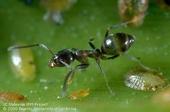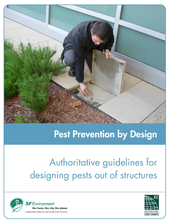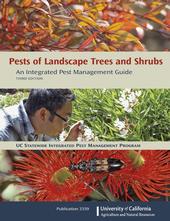
Download the free booklet at the bottom of the page!
1. Ants
Most people deal with ants around their home at some point. Because most ants live outdoors, focus efforts on keeping ants from entering buildings by caulking entryways. Follow good sanitation practices to make your home less attractive to ants. Spraying ants inside the home will not prevent more ants from entering. Use baits to control the ant colony. Pesticide baits work by attracting worker ants who then take the poison back to the nest where the entire colony, including queens, can be killed. In the landscape, ants protect...
- Author: Karey Windbiel-Rojas
![Adult honey bee [Photo by J. K. Clark]](https://ucanr.edu/blogs/UCIPMurbanpests/blogfiles/37046small.jpg)
In observance of National Pollinator Week, we thought we'd share how you can manage pests around your home, garden, and landscape and still protect pollinators.
Natural enemies (predators, parasites, and pathogens) reduce pest populations and help prevent damage to plants. Pollinators such as domesticated honey bees, wild bees, and other pollinating insects, are essential in the production of many of the fruits, vegetables, and nuts we grow in California, both in our backyards and in commercial agriculture.
Natural enemies and pollinators can be harmed by pesticides...
- Author: Mary Louise Flint

One of the best ways to reduce pest problems in and around buildings is to construct or retrofit structures that keep pests out in the first place. This concept has been a pillar of integrated pest management for many years. Pest-resistant buildings reduce not only pest problems but also the need for pesticide applications. Unfortunately, architects and builders had few guidelines about how to design and construct such structures.
To address this issue, the San Francisco Department of the Environment and the International Code Council developed an online publication, Pest Prevention by Design, which provides the first comprehensive resource on pest-preventive building design tactics.
Specific guidelines are...

Completely revised and expanded, Pests of Landscape Trees and Shrubs, 3rd Edition, is a comprehensive, how-to integrated pest management (IPM) resource for landscapers, arborists, home gardeners, retailers, and parks and grounds managers. This easy-to-use guide covers hundreds of insects, mites, nematodes, plant diseases, and weeds that can damage California landscapes.
The book's 435 pages present the practical experience and research-based advice of more than 100 University of California (UC) and industry experts, including:
• Pest-resistant plants and landscape design:
• Planting, irrigating, and other cultural practices that keep plants healthy:
• Conserving natural enemies to...
![Asian citrus psyllid and nymphs. [Photo by M.E Rogers]](https://ucanr.edu/blogs/UCIPMurbanpests/blogfiles/34236small.jpg)
News release from California Department of Food and Agriculture
SACRAMENTO – January 25, 2016 – A new portion of Fresno County has been placed under quarantine for the Asian citrus psyllid (ACP) following the detection of one ACP within the City of Fresno. The quarantine zone measures 97 square miles, bordered on the north by W Alluvial Avenue; on the south by W North Avenue; on the west by N Chateau Avenue; and on the east by S Chestnut Avenue. The quarantine map for Fresno is available online at: www.cdfa.ca.gov/go/acp-maps. Please...


